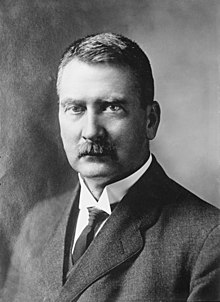David W. Taylor
| David Watson Taylor | |
|---|---|

Taylor in 1917
|
|
| Born |
March 4, 1864 Louisa County, Virginia, CSA |
| Died | July 28, 1940 (aged 76) Washington, D.C. |
| Allegiance |
|
| Service/branch |
|
| Rank |
|
| Awards |
Distinguished Service Medal Legion of Honor John Fritz Medal Franklin Medal (1917) |
Rear Admiral David Watson Taylor, USN (March 4, 1864 – July 28, 1940) was a naval architect and engineer of the United States Navy. He served during World War I as Chief Constructor of the Navy, and Chief of the Bureau of Construction and Repair. Taylor is best known as the man who constructed the first experimental towing tank ever built in the United States.
Taylor was born in Louisa County, Va. He entered the United States Naval Academy in 1881, after graduating from Randolph-Macon College where he was a member of Phi Kappa Psi. He graduated from the Academy in 1885 at the head of his class, setting a scholarship record, which still stands today. He was then sent to Greenwich, England in 1885 and received the highest honors of the Royal Naval College, Greenwich, in 1888, again setting a record.
In August 1886, Taylor was appointed an assistant naval constructor. Early in his naval career he served on various stations and in 1909 acted as chief of the Navy's Bureau of Construction and Repair. In 1895 he was the first American honored by award of a gold medal of the British Institute of Naval Architects.
In 1898 he constructed and had charge of the first experimental tank for models of war vessels built in the United States. He was connected with boards dealing with hull changes of naval vessels. In probably the greatest achievement of his career he created the "Taylor Standard Series" of 80 models with systematically varying proportions and prismatic coefficient. This series is still used for preliminary estimates of ship resistance for twin screw, moderate to high speed naval ships. The book was revised in 1933 with the addition of data on 40 new models. The series data was re-analyzed using more recent methods of evaluating friction resistance, and the results were published in 1954. Both "Speed and Power" and the Reanalysis were republished by the Society of Naval Architects and Marine Engineers in 1998, the centennial of the EMB.
...
Wikipedia
